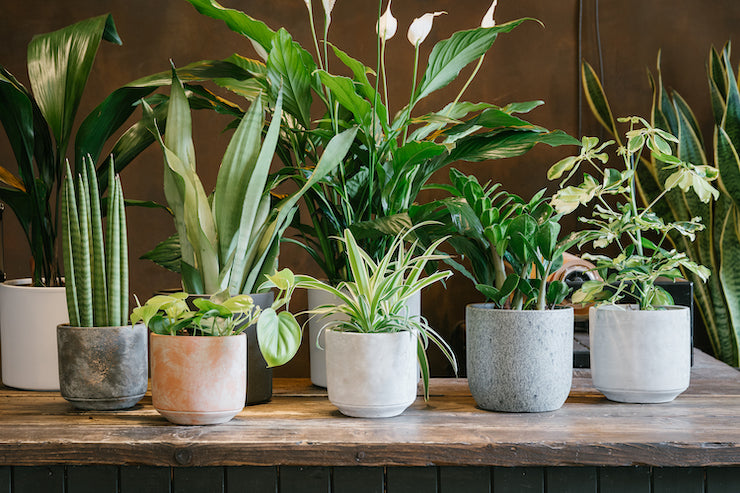
Care Guide: Staghorn Fern
Platycerium bifurcatum are a member of the Polypodiaceae family and are native to the tropical rainforests of Southeast Asia and Australia.
These fascinating ferns are epiphytic and latch their roots systems on to barky tree trunks. The Platycerium bifurcatum grows 2 types of fronds. The most obvious are the deep green antler-shaped fronds which can grow to around 3 feet in length and are what inspired their common name: Staghorn Fern. Like all ferns, it will produce spores on the underside of their ‘Antler Fronds’ for reproduction. The second type of frond are paddle-shaped and referred to as ‘Shield Fronds’. These can be found growing at the base of the plant. Not only do they take up water and nutrients from dead organic matter on the tree trunk, but also flatten themselves against the trunk to protect their rhizomes and root system. Initially they are lush and green, but as these fronds mature and will turn crispy, brown. In the home they can be grown in compost, however it is common to display them like a stag’s head, by mounting the fern with moss on a wooden board for a living decorative wall feature.
General Care Platycerium bifurcatum
Staghorn Ferns prefer to be positioned in bright indirect light, however, can tolerate slightly shadier spots and best kept away from cold draughts. It is important to remember that these plants grow in highly humid rainforest environments and should therefore be misted frequently throughout the week to prevent the fronds becoming crispy and give it the illusion of a humid environment in your home. Placing the plant in often more humid rooms, like a bathroom or kitchen, will help with this. However, they will still need to be misted with water in a spray bottle for best results.
Although these plants are humidity lovers, they are relatively drought tolerant as they gain moisture from occasional rainfall. Look out for wilting leaves as a sign your Staghorn Fern is ready for a drink. When watering at home they require dunking into a basin of water for around 5 minutes to fully immerse the root ball. A high-quality plant food such as Liquid Gold Leaf should be applied every 2 to 4 weeks during the growing season (March-October).
There are multiple ways to grow Platycerium bifurcatum as a houseplant. One method is to grow them in pots using a Epipythetic compost mix made up of 30% Soil.Ninja Base Mix with 50% Bark and 20% Zeolite. This light, loose mix creates large air chambers for the plant's larger root systems to crawl through and attach as if they are clinging to tree trunks. It also creates optimum levels of drainage and aeration for happy, healthy root growth. Alternatively, some prefer to grow these plants in Sphagnum moss or coir and mount them onto wooden boards using horticultural wire. We recommend using Soil.Ninja Sphagnum Moss for this.
Tips and Tricks for Growing Staghorn Ferns in the UK
Why have the Shield Fronds turned brown and crispy?
The paddle-shaped fronds at the base of this plant are green when they are young, however as these mature they turn brown and crispy. This is a perfectly natural part of the ferns life cycle and are not a sign the plant is unhappy. Do not remove these fronds when they turn brown and crispy. They have adapted to shield and protect the plants root system and are key to keeping your plant healthy.
Dusty Leaves
This is not dust and is in fact the natural surface texture of the frond and helps to protect the plant from sun scorch. Do not attempt to remove this.
Wilting Fronds
Wilting fronds tends to be a sign of underwatering, so ensure your Fern is kept sufficiently watered.
Why are the leaves turning brown and crispy?
Staghorn Ferns require high levels of humidity to prevent their antler shaped fronds from drying out. Increase your misting throughout the week and ensure your plant is not placed too close to a dry heat source such as a radiator or fireplace. Ensure your fern is not positioned in direct sunlight as this will scorch the leaves.
Why are brown masses appearing on the underside of the main fronds?
Platycerium bifurcatum produce groups of spores to reproduce. These can be identified as brown clusters on the underside of the tip of the antler shaped fronds.



